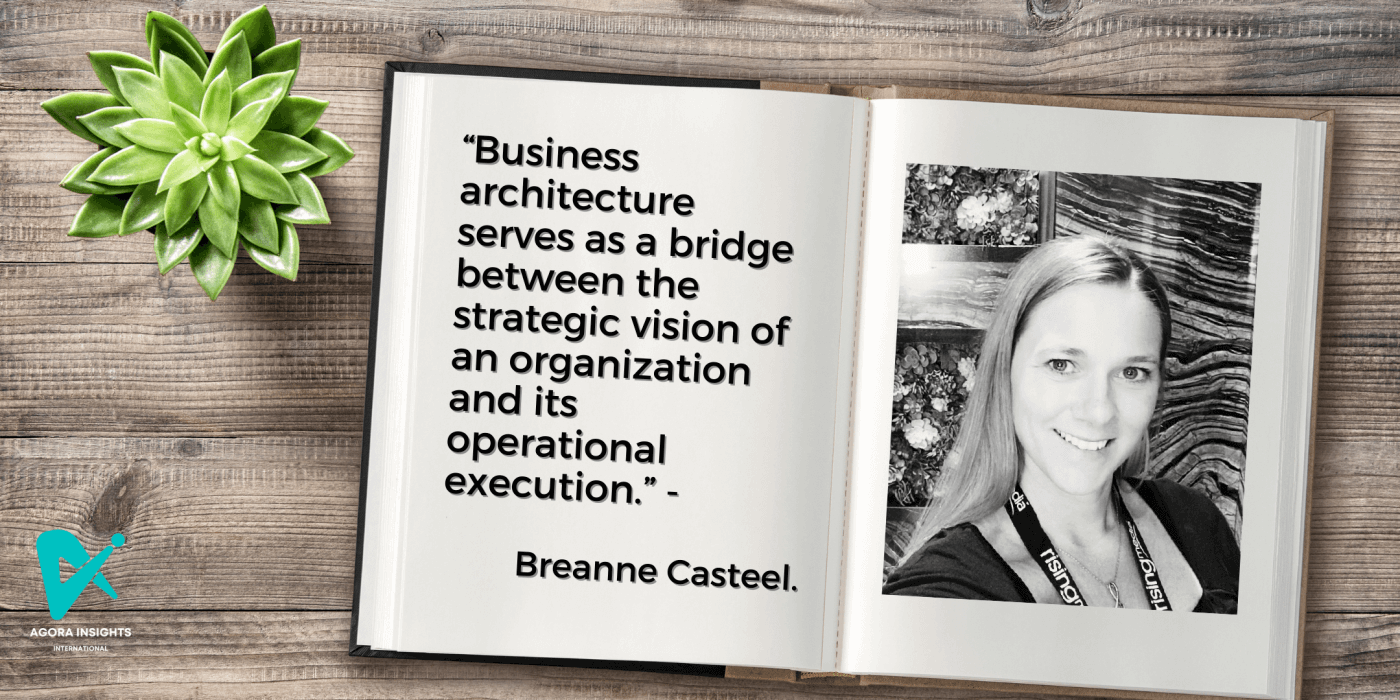I’m delighted to share insights from Breanne, who recently moved from senior business analyst to business architect.
With over 20 years of experience, Breanne is a passionate advocate for bringing business analysis and now architectural skills to organizations. Known for her organization skills and leading successful projects, Breanne focuses on communication, transparency, and collaboration.
She holds an impressive array of certifications, including Certified Business Architect (CBA), Agile Analysis Certified (AAC), Certified Product Ownership Analyst (CPOA), and Entry Certificate in Business Analysis (ECBA). And I am thrilled that she chose Agora Insights for some of these studies!
“If you’re not learning and growing, then you’re actually falling behind.” Breanne Casteel
Background
Her professional journey began with a foundation in computer science, a field she had not actively pursued since college. However, it was her technical background that paved the way for her eventual transition into tech support, where she honed her skills in interfacing with end users and programmers. This intermediary role was critical because it taught her the value of not taking feedback personally and instead viewing it as an opportunity for growth—a mindset that would serve her well in her future roles. It also uncovered that her passion lay in the people side of technology.
One of the most intriguing aspects of Breanne's story is her progression from technical support to quality assurance to business analyst, and finally to business architecture. It was a progression that involved not only climbing a career ladder but also identifying and filling gaps within her organization. Her passion for the people side of the business, the realization that business analysis was a "thing," and the subsequent discovery of business architecture as a means of addressing strategic alignment issues demonstrate a proactive approach to career development.

Three Key Topics Discussed:
1. The Importance of Strategy and Alignment:
The shift from business analyst towards business architecture was born from Breanne's realization that a critical piece was missing in her work as a business analyst: strategic alignment. The desire to understand the larger 'why' behind projects and to ensure alignment with business objectives led her to explore and eventually embrace business architecture. Business architecture, as Breanne describes, serves as a bridge between the strategic vision of an organization and its operational execution. It offers a framework for aligning initiatives with business objectives and ensuring resources are effectively utilized. Her role in implementing a new accounting system highlighted the practical benefits of business architecture in real-world applications.
"A business architect frames the 'Why' and enables the 'How'"
- Breanne Casteel
2. The Importance of a Growth Mindset:
A recurring theme in Breanne's narrative is the significance of a growth mindset. Her curiosity, her perseverance, and her ability to embrace change, to seek continuous improvement, and to learn from every situation has been pivotal in her career. Her journey underscores the idea that one's professional development is a perpetual work in progress, where each challenge is an opportunity to expand our skill sets and influence.
3. Business Architecture as an Enabler:
Breanne's insight into the role of business architecture in organizations highlights its value as an enabler rather than a silver bullet. She discusses how business architecture helps to connect the dots across various initiatives, ensuring alignment with strategic objectives and facilitating resource planning. This strategic vantage point allows for better decision-making and more efficient use of resources. Breanne's journey into business architecture has already begun to show its value within her organization. By starting with foundational elements like value streams and capability overlays, she has been able to validate business needs while providing immediate value, illustrating the practical benefits of business architecture.
Ten Learning Points:
- Growth Mindset: Embrace continuous learning and evolution in your career. Have confidence in yourself and enjoy the journey of continuous learning. Stay ahead of the curve and develop a well-rounded toolkit with frameworks, methodologies and interpersonal skills.
- Collaboration: Work closely with various stakeholders to achieve common goals.
- Listening: Pay attention to the needs expressed by users and stakeholders. Listen closely to identify the unspoken needs within an organization.
- Adaptability: Be willing to transition and apply skills in new contexts.
- Strategic Thinking: Understand and align projects and initiatives to the broader business objectives and strategy. Balance strategic thinking with delivering practical solutions.
- Value Focus: Lead with outcome-focused solutions that provide tangible benefits.
- Efficiency: Use business architecture to reduce redundancy and improve processes. Document institutional knowledge for future reuse.
- Resource Management: Optimize resource management through planning, prioritization and capacity analysis. Balance workloads and prioritize initiatives effectively.
- Enabling Others: Facilitate success without needing personal recognition.
- Networking: Engage with the community and learn from peers in the field.

Conclusion:
In closing, Breanne Casteel's journey and insights offer a compelling look into the dynamic and impactful role of business architecture. Her story is a reminder that our careers are not fixed paths but evolving journeys that benefit from our willingness to learn, adapt, and sometimes even venture into the unknown. In her example, we see how she continues to blend her technical expertise with strategic thinking in the architectural space.
The conversation with Breanne was not just informative, it was inspiring, as it shed light on the multifaceted nature of business architecture and the profound impact it can have when applied thoughtfully and strategically.
“(I enjoy) Finding a need that people didn’t even know they were expressing... and acting on it.” - Breanne Casteel.
I trust that you too have enjoyed this conversation and that it has inspired you to further your learning! Don't forget that Agora Insights truly guides learner to success! Let me know in the comments anything that resonated with you and any questions you have in mind.
Feel free to share in our Blueprints for Success Podcast or comment with any questions!

To get weekly videos and interviews from leaders around the world subscribe to our Blueprints for Success Newsletter on LinkedIn
Learn more about Breanne
Breanne is best contacted through LinkedIn
Post sponsored by Agora Insights Ltd

.png)

Post a Comment